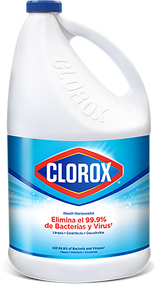Information About Bleach

Clorox® Bleach offers consumers effective, cost-efficient cleaning and disinfecting.
How is bleach made?
To make bleach, Clorox uses liquid chlorine gas to make the sodium hypochlorite active, (NaOCl). Th chlorine gas comes from the electrolysis of salt water. The chlorine gas gets bubbled through a solution of water and caustic to make the dilute household liquid bleach solution (5% sodium hypochlorite active). The reaction is carried out in a closed, sealed container so there is no free chlorine in the product afterward.
How does bleach work?
When you buy a bottle of Clorox® Bleach, you are buying a solution of at least 5% sodium hypochlorite with a little sodium hydroxide and sodium carbonate to help buffer the solution and help maintain product performance for up to a year. Sodium hypochlorite is a very reactive chemical. It reacts quickly, and effectively breaks down stains and soils into smaller parts that allow them to be more easily removed from surfaces and fibers. It is also an effective disinfectant which kills 99.9% of bacteria on hard, nonporous surfaces. *
Is bleach safe?
After its use in cleaning or laundry, sodium hypochlorite breaks down into 95 % to 98 % salt and water. Read the label carefully before use. The remaining 2 to 5 % is dispersed through the sewage system or septic tank, where it continues to react against any dirt it encounters until it is completely deactivated. Liquid bleach does not come into contact with the environment because it reacts with organic matter in the plumbing.
* For more information, read the label carefully.
Products You Can Use
Advice From Our Experts
-
 How-To
How-To
-
 How-To
How-To
